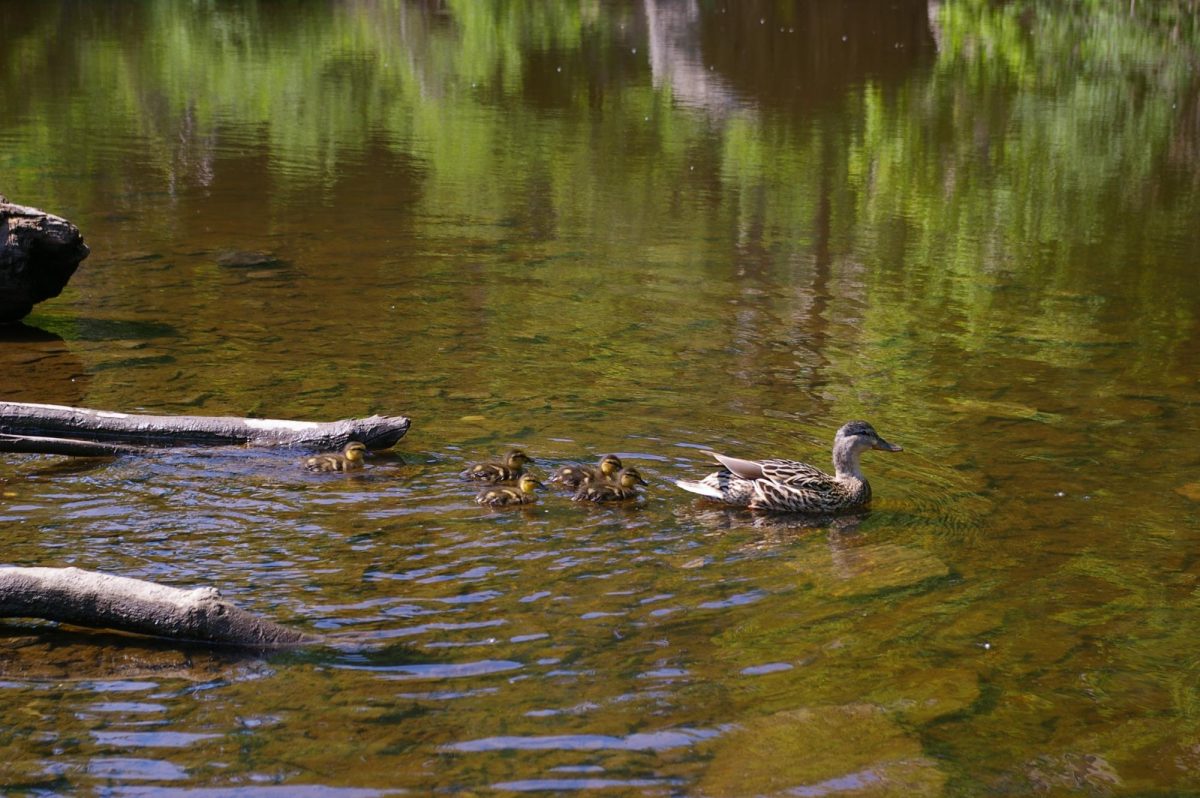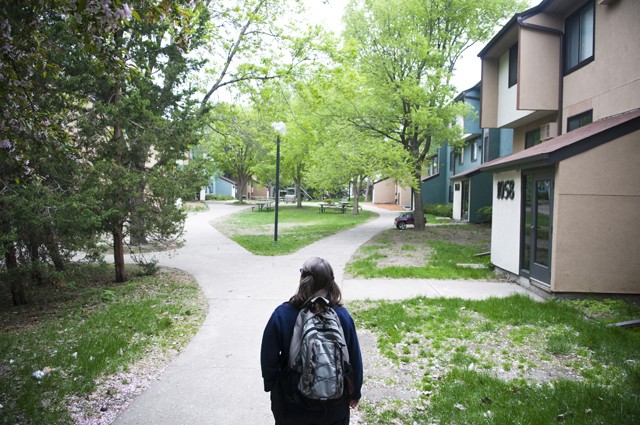On Sept. 18, 2008, the phone rang in Janet Dalgleish’s basement office at Boynton Health Service. Dalgleish, the University of Minnesota environmental affairs coordinator, was told that construction workers at the Como Student Community Cooperative had been waterproofing one of the buildings when they found ash, stained soil and debris. They immediately stopped working. In the days and months that followed, lab tests revealed that the soil around three CSCC apartments, which are University-owned and tailored to married graduate students, was contaminated with alarming levels of cadmium, lead and carcinogens. As Dalgleish saw it, the University could either dig up and replace millions of pounds of soil or close three apartment buildings. âÄúIt wasnâÄôt acceptable to do nothing,âÄù Dalgleish said. âÄúThat was not one of the choices.âÄù Last fall, the worst of the soil was dug up, trucked off and replaced. The second and final phase of remediation is set to begin next week. Some CSCC tenants have complained that they were not fully informed of the contamination, and members of the Southeast Como Improvement Association have wondered aloud about the extent of contamination and whether the University itself had put down the tainted soil. In fact, the origin of the contaminants dates back to a time when city incinerators burned at low temperatures, businesses and citizens dumped toxic trash in vacant lots and little was known about the relationship of the environment to human health. Relatively high In choosing the spots to test, Dalgleish sought samples from what she guessed were the most contaminated areas. She guessed right. The levels of lead and cadmium found deep under the surface were several times higher than the accepted threshold for residential sites. But DalgleishâÄôs greatest concerns were polycyclic aromatic hydrocarbons (PAHs), cancer-causing molecules. MinnesotaâÄôs recognized limit for residential exposure to PAHs is 2,000 parts per billion. One sample from CSCC came out at more than 25,000 parts per billion of PAHs and another was 31,000. Residents at CSCC would not have been exposed to these soils, which were several feet beneath the surface. But soil taken at the surface level revealed contamination which, though considerably lesser than that found at greater depth, was also above state and federal risk limits. Residential limits for metals and carcinogens are calculated based on the hypothetical risk to a person who spends his or her entire life with regular exposure to a contaminated site. Most CSCC residents live there an average of two to three years, and the apartments have a maximum residency of seven years. Dalgleish, who is not a risk assessor but has some knowledge of hazardous sites, said exposure to PAHs at 2,000 parts per billion increases oneâÄôs risk of cancer by roughly one in 100,000. âÄúAs a state, weâÄôre trying to keep our risk level similar to being struck by lightning,âÄù Dalgleish said. Stephen Hecht, a professor and Wallin Chair in Cancer Prevention at the University Masonic Cancer Center, has studied carcinogens, including PAHs, extensively. Of the deeper samples, Hecht described the findings as âÄúrelatively high.âÄù âÄúThe question is,âÄù Hecht said, âÄúwhat are people doing with the dirt?âÄù Hecht said that only consistent exposure to high-level PAHs, or a brief but serious exposure âÄî such as ingesting a handful of soil or âÄúcovering yourself with the dirtâÄù âÄî would lead to a dramatically increased risk of cancer. Soil replacement by the numbers The UniversityâÄôs investigation and removal project, with a total cost of about $1.3 million, was funded by a series of grants from Hennepin County through the Environmental Relief Fund. When the last delivery of clean soil is made to the CSCC this June, more than 63 million pounds of soil will have been transferred more than tens of thousands of miles, making it one of the largest projects Dalgleish has worked on in her 30 years. She thinks that the presence of young couples and their children helped set a pace that will see the remediation finished roughly 20 months after the contamination was discovered. âÄúThis is, like, the fastest- moving project I think IâÄôve ever seen,âÄù Dalgleish said. EverybodyâÄôs exposed When he linked soot exposure to the prevalence of scrotal cancer among chimney sweeps in 1775, English doctor Percivall Pott made the first environmental connection to cancer. The chimney sweeps had been working in PAHs. More than two centuries later, PAHs are among the most common carcinogens found in the human environment. âÄúTheyâÄôre ubiquitous,âÄù Hecht said. âÄúEverybodyâÄôs exposed.âÄù PAHs, byproducts of partially burnt material, are introduced to humans through inhaling smoke from a cigarette or factory smokestack. But higher levels are also found in people who eat a diet heavy in grilled meat. Hecht said that scientific knowledge of PAHs is still incomplete: Both the human response to various doses and the exact way in which they affect the bodyâÄôs cells are unknown. âÄúThereâÄôs still a lot of questions,âÄù Hecht said. âÄúBut thereâÄôs no doubt theyâÄôre carcinogenic.âÄù The poisonous effect of lead on children was found in the late 19th century, but public health administrators at the local and national level have yet to eradicate its presence. Lead was in American paint until 1977 and was not completely banned from gasoline until the Clean Air Act of 1996. Dalgleish said that the lead exposures at the CSCC site, while high, were not uncommon. âÄúThese numbers are nothing compared to people living in hundred-year-old houses in Minneapolis,âÄù Dalgleish said. âÄúMy yardâÄôs far worse.âÄù The full extent of leadâÄôs damage to the developing brain is unclear, but studies have linked lead exposure to lower IQ and aggression. Both the Centers for Disease Control and Prevention and the Minnesota Department of Health are reconsidering the âÄúelevatedâÄù levels of lead presence in blood. Currently, the threshold is 10 micrograms of lead per deciliter of blood in children under 6 years old. But doctors have said that even half as much lead in the blood could have subtle but damaging effects on the young brain. Unsuitable conditions The land, which now holds 13 rectangular apartment buildings, paved walkways, two playgrounds, a grass field and a day care, was once owned by the Iowa Development Company. Until the mid-1940s, the empty lot was used as a dumping ground. Among the debris found during the excavation was the sole of an old shoe, part of a tricycle and a childâÄôs toy truck. Lynne Grigor of the Minnesota Pollution Control Agency believes that the contaminated soil may have come in part from one of the cityâÄôs incinerators, which was used by businesses, including those in heavy industry. At that time, some incinerators burned at around 400 degrees Fahrenheit, a temperature more suited to cooking chicken than obliterating dangerous chemicals. As the University expanded near the middle of the 20th century, the company feared its land might be claimed by the school via eminent domain and instead wanted to sell it. But the land, unsold for decades, had no market value. So the Iowa Development Company created a market by selling the land to Clement and Olga Seng, a couple from California, 10 days after the end of World War II. The next month, the Sengs made a quick profit of $3,000 by selling the land to the University for $33,000. The University immediately built Quonset huts on the land. Like the CSCC, the housing was marketed to married graduate students. By 1957, the Quonsets were torn down, and for the next two decades, the land was again a vacant lot. What had once been a dumping ground was instead used by the University as a field for intramural sports. In 1977, the first 10 apartments were built. In 1981, as the University considered building what would become the 11th, 12th and 13th buildings, the land underwent a soil evaluation. University documents from that year indicate that construction workers evaluating the site found glass, bits of concrete and ashy soil in several spots. Moreover, the report found âÄúslag,âÄù a byproduct of smelting ore, in at least two sites. Though the workers were almost certainly finding the same nasty mix that has since been identified, the evaluation seemed concerned with the weak foundations of the ashy spots and not its potential contamination. âÄúIn the eastern part of the site âĦ the conditions are unsuitable,âÄù the report said. âÄúThere, the surficial soils should be removed and replaced with compacted fill.âÄù Though it is unclear if this recommendation was followed, no mention is made in the reportâÄôs finding about any harmful effects of the substances found at the site. Dalgleish, who attended graduate school at the University around the time of this report, said the early 1980s were, in essence, the last time a contaminated site like this could have been missed. Environmental consciousness grew during that decade, Dalgleish recalls, and by 1990 the University was evaluating individual plots of land before purchasing. By 1993, no bank would give a loan unless the soil had been tested. âÄúWe never buy anything without knowing what weâÄôre buying now,âÄù Dalgleish said. SECIAâÄôs suspicions and concerns Last November, in response to the soil removal project, SECIA sent a newsletter to residents referring to discoveries as âÄútroubling.âÄù The letter, which was also posted to SECIAâÄôs website, said that âÄúgiven the possibility that there could have been some cross-contamination of soil over the years, we are seeking help in broadening the soil and are contacting the MPCA, Hennepin County and local officials, asking for their help.âÄù Justin Eibenholzl, environmental coordinator for SECIA, was at first skeptical about the source of the contaminated soil. âÄúWe have no idea,âÄù Eibenholzl said. âÄúThat ash, was it brought in at some point? Was it put around the buildings?âÄù When asked whether he believed the UniversityâÄôs explanation that the soil was contaminated at the time of the siteâÄôs purchase in 1945 âÄî a claim supported by a series of pre-purchase aerial photographs âÄî Eibenholzl said that this story of the siteâÄôs origin was âÄúpossible,âÄù but that it still should have been found and removed in the 1980s. âÄúIf it was there, fine, thatâÄôs great,âÄù Eibenholzl said. âÄúWhatâÄôs the source? Whatever. But you built buildings in a toxic ash dump âĦ something that no one can do.âÄù Eibenholzl said that sometime this month, SECIA would be applying for a grant to begin testing other residential sites in the neighborhood to see if the contamination carried over onto other properties. Expectations and implications On Sept. 18, 2009, one year to the date after construction workers first found ashy soil, Taqee Khaled moved into his new apartment at CSCC. Khaled recalls noticing that soil was being removed at the time but said it had never been made clear to him what had spurred the project. It was not until November that Khaled, who lives with his wife and their young child, learned of the removal by reading about it in a Minnesota Daily article. âÄúI donâÄôt know how I could have moved into a place that was having soil removal going on with chemical contaminants that we werenâÄôt told about,âÄù Khaled said. Khaled, whose parents had lived at CSCC 20 years earlier, said the fact that he wasnâÄôt told fits into a pattern of poor communication and maintenance he has observed. He thinks CSCC management may take advantage of the fact that so many of its residents are foreign and so have lower expectations. The same could not be said, though, of Angie Einerson, who grew up in Alexandria, Minn. On Saturday, Einerson said that as she and her husband moved from one CSCC building to another, it was not made clear that they were moving closer to the contaminated soil site. âÄúI would say it was kind of vague,âÄù Einerson said. âÄúI still donâÄôt really know what it was for.âÄù Neither Einerson nor her husband Dan, who is studying dentistry at the University, asked questions or approached management to find out more about the ongoing project. But despite the fact that they do not have children, the Einersons feel management should have explained the project without their asking. Kendra Hernandez, who has been CSCC board president for almost two years, was among the first residents notified about the discoveries. Hernandez said Dalgleish wrote a letter to tenants explaining the projects and offered herself as a resource. Hernandez, who at the time had two young children and now has a 5-month-old baby, said DalgleishâÄôs honesty put her at ease. âÄúI was never worried,âÄù Hernandez said. âÄúSome members of the board were maybe more concerned than I was.âÄù Hernandez said the day after the first removal project was completed, her husband and kids were back playing soccer on the field. Among the most concerned tenants was Julie Rundall. RundallâÄôs son and three daughters, who now range in age from 9 to 14, had a particular interest in digging deep into the playground sand. âÄúThey would dig up to their chests and stand in it,âÄù Rundall said, laughing. In their digging, RundallâÄôs kids had found pots, pans and âÄúother junkâÄù underneath the playground. When she expressed concern, Rundall was put through to a risk assessor, who said it would be a good idea to test her kidsâÄô blood-lead levels. In spring 2009, Rundall had each of her four kids tested, and said their lead levels were not only low, but nonexistent. âÄúThey came through clean,âÄù Rundall said. When a different concerned mother, whose son was also a âÄúdigger,âÄù called her office, Dalgleish explained the situation to her and then asked that she put her son on the phone. âÄúWe have to ban all digging right now,âÄù Dalgleish told him. âÄúBut weâÄôll fix this place up so you can dig again in the future.âÄù Joanna Herm said no mention was made of contaminated soil as she and her husband moved into CSCC last spring. The Herms are uniquely qualified to talk about their experience with the soil removal: She works as a nurse, and as an undergraduate at Bethel University, she wrote a paper on the effects of lead on the brains of growing children. She knows that the risk lead exposure poses to adults is minimal compared to children, but she still wishes sheâÄôd been told about the contamination. âÄúIt is kind of just disappointing that the environment that we live in âÄî that nothing was really put forward to us,âÄù Herm said. âÄúAnd I think I would be angry âĦ if I had kids.âÄù HermâÄôs husband Ryan is studying landscape architecture and said that in his ecology class heâÄôd learned about the history of sites like the one he lives on now. âÄúYou know, post-war building, they kind of just said, âÄòHeck weâÄôre going to throw this on top of this and do whatever we want to the soil,âÄô âÄù he said. âÄúBut now, with this whole green movement, people are starting to understand the implications of that.âÄù -Reporting contributed by Austin Cumblad, Ian Larson and Alex Robinson.











